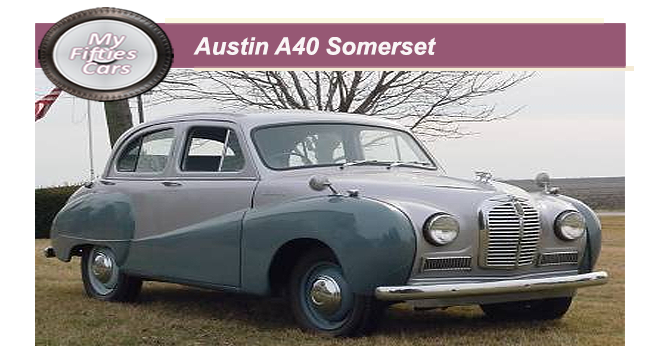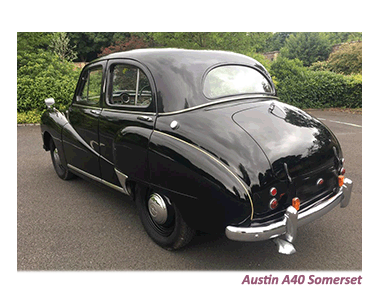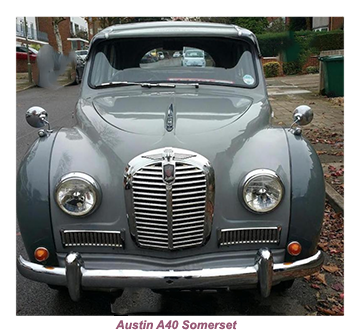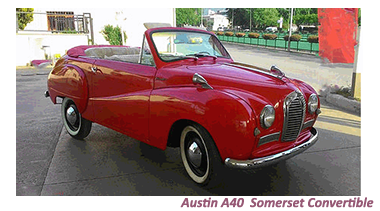
The early Fifties witnessed massive leaps forward in global car design, although BMC were not one of the companies that could reasonably take an active part.
The reason was that, despite Austion being a key player in this brave new world, the company lacked the financial resources to restructure their production lines completely. This meant they could only afford to produce inadequate updates of existing, obsolete models. D espite this barrier, the Austin Motor Company entered the decade with one of the most notable of the early post-war successes to their credit.
espite this barrier, the Austin Motor Company entered the decade with one of the most notable of the early post-war successes to their credit.
 The A40 Devon (Four Door) and Dorset (Two Door), introduced in late 1947 had gained worldwide approval, especially in the United States, placing the range as Britain's biggest dollar earning car up to that time.
The A40 Devon (Four Door) and Dorset (Two Door), introduced in late 1947 had gained worldwide approval, especially in the United States, placing the range as Britain's biggest dollar earning car up to that time.
 Following in the footsteps of the Devon and Dorset came the A40 Somerset, which was an ideal example of the dilemma that Austin found themselves in.
W>hile the Somerset had a dated design, through time it has been accepted as a pleasant, comfortable car with reasonable character.
To allow the Somerset to get up and running, Austin simply took the running gear of the A40 Dorset series, which was already regarded as antiquated, and gave it a revamped body design, a cross between the A70 Hereford and the compact A30.
Following in the footsteps of the Devon and Dorset came the A40 Somerset, which was an ideal example of the dilemma that Austin found themselves in.
W>hile the Somerset had a dated design, through time it has been accepted as a pleasant, comfortable car with reasonable character.
To allow the Somerset to get up and running, Austin simply took the running gear of the A40 Dorset series, which was already regarded as antiquated, and gave it a revamped body design, a cross between the A70 Hereford and the compact A30.
![]()
The Austin A40 Somerset proved to be a commercial success, thanks to its prominent sweeping line down from the top of the front wing and the distinctive grille, which helped to ensure a place for the car in the British public’s buying consciousness, although they were not exactly spoiled for choice.
Th e most interesting variant of the Somerset was the convertible, with a body built by principal Austin production confederate, Carbodies of Coventry, who also supplied the body for the similarly styled but larger A70 Hereford convertible.
e most interesting variant of the Somerset was the convertible, with a body built by principal Austin production confederate, Carbodies of Coventry, who also supplied the body for the similarly styled but larger A70 Hereford convertible.
O f entirely conventional design, the A40 Somerset featured a separate chassis frame of longitudinal box section members with transverse members front and rear.
f entirely conventional design, the A40 Somerset featured a separate chassis frame of longitudinal box section members with transverse members front and rear.
Bolted to this chassis was roomy bodywork which, in four-door form, was of six light window design.
 Flowing wing lines — with built-in headlamps at the front — and the lack of running boards were up-to-date features which gave the A40 a modern appearance, while a minor increase in width provided a little more passenger space, thus making the Somerset unusually roomy for a 1200cc car.
Flowing wing lines — with built-in headlamps at the front — and the lack of running boards were up-to-date features which gave the A40 a modern appearance, while a minor increase in width provided a little more passenger space, thus making the Somerset unusually roomy for a 1200cc car.
A useful feature of this bodywork desigh was the rear-hinged deep sided bonnet which gave excellent side access for routine maintenance.
![]()
At the rear was a rather small luggage boot compensated by providing the benefit of a drop-down lid with hinges sufficiently strong to allow the lid to be used as a platform or even a picnic table.
As had been the case with A40 Devon, the Somerset’s spare wheel was housed in the luggage compartment beneath a false floor. Passenger doors were front hinged, a departure from the suicide doors that had become popular in the Thirties and late Forties. T he A40 Somerset's interior was finished to a higher standard that would be expected for what was a relatively inexpensive car.
he A40 Somerset's interior was finished to a higher standard that would be expected for what was a relatively inexpensive car.
 Standard equipment included such luxuries as window winding mechanism in the doors, with the addition of swivelling quarter windows, twin sun visors, comprehensive instrumentation, and a sprung three-spoke steering wheel.
As the Fifties advanced and more attractive alternatives began to appear, these family Austins were not quite so well-placed in their respective classes.
Nevertheless, they continued to command a share of the market well into the Fifties.
The Somerset remained in production until October 1954 when it was replaced by the new monocoque-bodied Cambridge and Westminster models.
Standard equipment included such luxuries as window winding mechanism in the doors, with the addition of swivelling quarter windows, twin sun visors, comprehensive instrumentation, and a sprung three-spoke steering wheel.
As the Fifties advanced and more attractive alternatives began to appear, these family Austins were not quite so well-placed in their respective classes.
Nevertheless, they continued to command a share of the market well into the Fifties.
The Somerset remained in production until October 1954 when it was replaced by the new monocoque-bodied Cambridge and Westminster models.


